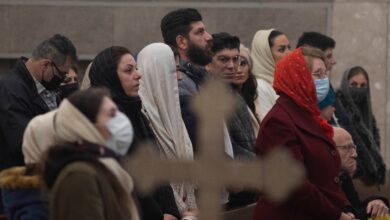From Catholicism is a cult to Catholicism is my faith

By Laura Bennett
Growing up a sola scriptura Evangelical Christian, the Bible was central: daily Bible readings, frequent Bible studies, memorizing and quoting lengthy passages, and even reading the Bible cover-to-cover multiple times were a matter of course.
Part of my upbringing also included being taught that Catholicism is an outright cult and that Catholics don’t know the Bible, which is why they hold so many outrageously erroneous beliefs on Mary, the Eucharist, etc.
Imagine my shock when I attended my first Mass in 2015 and heard familiar Bible verses left and right: passages from the Old Testament, New Testament, Gospels and Psalms, the direct quotes from Jesus at the Last Supper, and even scriptural echos sprinkled throughout the Mass (e.g. Mal 1:11, Mt 8:8-9).
I was dumbfounded. No matter how much we may have read (and interpreted!) the Bible on our own, Evangelical Sunday worship services didn’t come close to this level of Scripture proclaimed; we didn’t so much as regularly recite the Lord’s Prayer (the Our Father), which suddenly struck me as very bizarre.
This experience that Catholicism is apparently very Bible-friendly after all was a watershed moment that prompted me to wonder with some trepidation: “What else was I told about Catholicism that isn’t actually true?!” The answer to that question proved to be a laundry list indeed.
As is the case for probably many Protestant converts to Catholicism, Mary was one of the biggest stumbling blocks for me. I needed to be convinced that the Catholic perspective on Mary didn’t contradict the Bible, which was my hitherto operating assumption (spoiler: the biblical support for everything Catholics believe about Mary is astounding and continues to delight me to no end).
I started by exploring the dogma on Mary’s perpetual virginity, since Evangelicals typically believe she and Joseph went on to have more children after Jesus’ virgin birth. “The Bible and the Virgin Mary” video series on Formed was my essential guide as I worked through all my Mary-specific obstacles, and I highly recommend it.
As just one key example, I was prompted to re-read Luke’s account of the angel Gabriel visiting Mary and was confronted by her curious question “How shall this be, seeing I know not a man?” I used the King James Version, the version of the Protestant Bible I grew up on; I was suspicious of reading the Catholic Bible, since I had been taught that the Catholic Church “added” books to the Bible and otherwise wrongly fiddled with it.
For the first time, I heard the argument that Mary’s question is very strange, very telling. For, if you are married (betrothed) and would be planning on having marital relations, why would you ask about the birds and bees? Did Mary not know where babies come from? The very fact that she’s not simply assuming this promised baby will be conceived normatively is a strong indicator of her lifelong vow of chastity. I had surely read that passage (how many times!) growing up, but I hadn’t had the eyes to truly see what was right under my nose.
The same thing could be said of the Bread of Life discourse in John, Chapter 6, which, most ironically, is one of few Bible passages not taken literally by Evangelicals. Again, I found that a simple, face-value reading of the text points to the Catholic position: Jesus doubles down on his message instead of backing off under the pressure of his listeners’ murmurings and disputes, and indeed, many of his followers leave him over this issue of his flesh and blood being “food and drink indeed.”
Contrast that with how no one in my childhood church got offended and stormed out over a merely symbolic communion. Our cubes of Wonder Bread were not safely locked away in a tabernacle, and any leftover mini cups of grape juice were unceremoniously downed by the kids afterward in the kitchen. For why would something not real be stolen for sacrilegious purposes? And why would you revere something not real by your careful handling of it?
Whether we’re talking about Mary or the Eucharist or any number of other sticking points for Protestants in regard to Catholicism, I found that the Bible is a very Catholic book, if you read it right, which, as in these brief examples, I became convinced is sometimes as simple as honestly reading the black-and-white words on the page and taking them to their logical conclusions.
The ultimate logical conclusion for me was that I must become Catholic! And, so, I was received into the one, holy, catholic and apostalic Church in 2021, where I hear the Word of God faithfully preached, receive the body and blood of Jesus in the Eucharist, and enjoy a relationship with Mary, Ever Virgin, as my Blessed Mother, who leads me closer to her Son.
Not only is Catholicism basically the opposite of everything I was ever told, but it continues to be more than I could have ever imagined. All glory to God!
Laura Bennett is a parishioner at the Cathedral of Saint Joseph.
Source link




